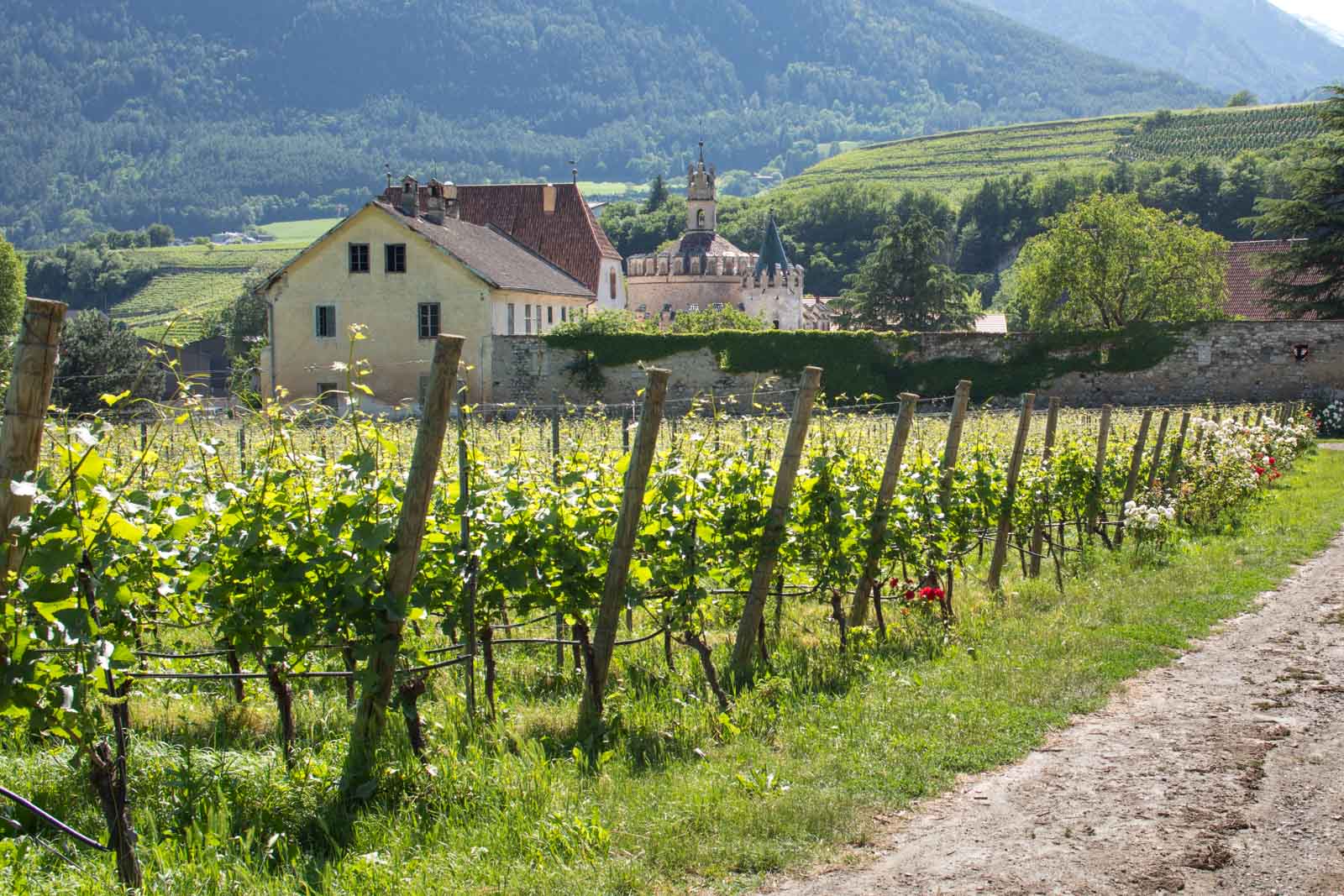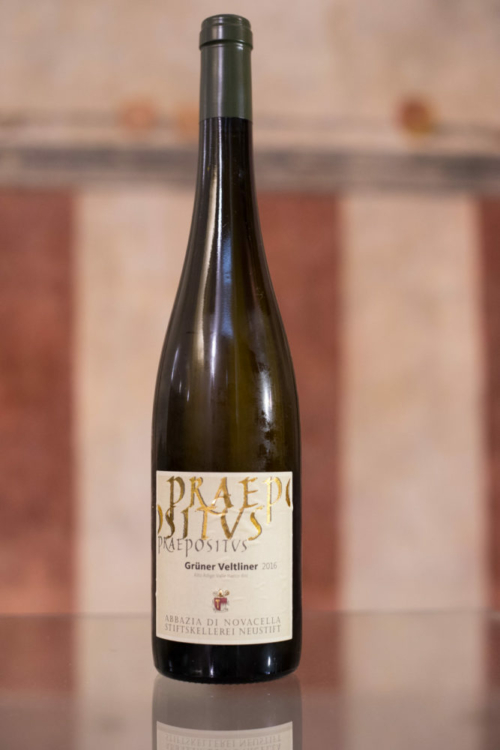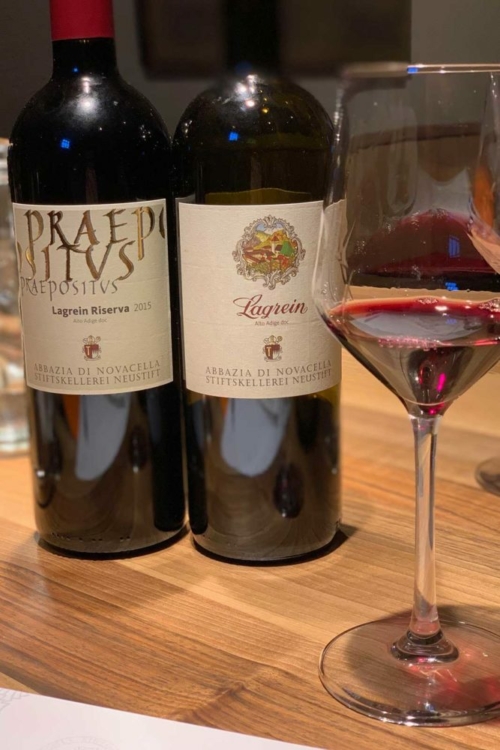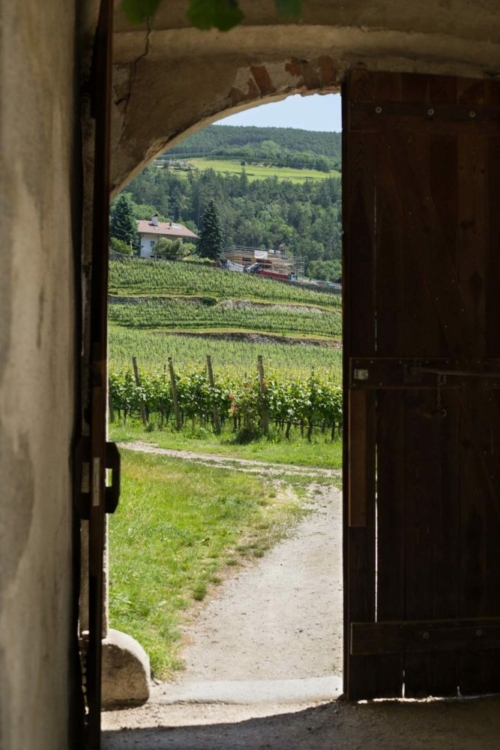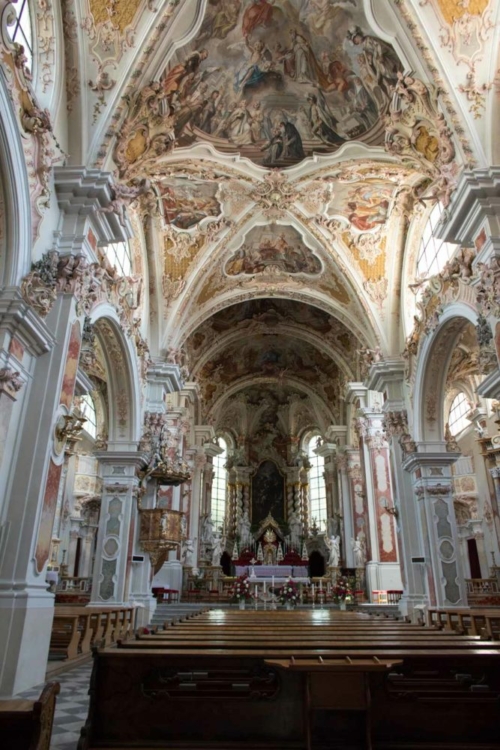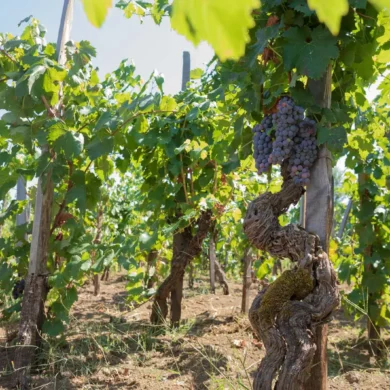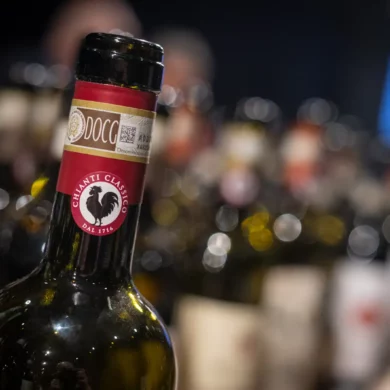Abbazia di Novacella boasts only two product lines: the entry-level “classic” wines, and then a more choice selection of grapes for each varietal called Praepositus, which is dedicated to the Abbot, the head of the monastery. Only one wine is blended (the St. Magdelener), and every wine has a Praepositus version with the exception of the Schiava.
Because there are only subtle aromatic and textural differences between these two lines, I’ve combined my tasting impressions for each varietal together.
Story continues below
[one_third]
 [/one_third][two_third_last padding=”0px 12px 0px 12px”]
[/one_third][two_third_last padding=”0px 12px 0px 12px”]
Abbazia di Novacella: Legend of the Alps
Learn more about the second oldest winery in Italy and how the Valle Isarco, where it is located, is among Italy’s most underrated terroirs.[/two_third_last]
Abbazia di Novacella Müller Thurgau
Another interesting cross that thrives in Alto Adige is Müller Thurgau (a cross between Riesling and Madeleine Royale). In terms of potential, the grape has its limits, in my opinion, but Abbazia di Novacella seems to do a good job reaching for them with its entry-level 2017 Müller Thurgau (★★★★ 1/4) and the 2017 Praepositus Müller Thurgau (★★★★ 1/2). This is due in part to the high-elevation of their vineyards, which helps to preserve the acidity needed to keep the wine from getting flabby. While the entry-level wine is more up-front and aromatic to start, the Praepositus is more detailed and intriguing. Both are defined by tones reminiscent of pineapple, peach and white flowers.
Abbazia di Novacella Sylvaner
For their Sylvaner, Abbazia di Novacella once again seeks inspiration from the north, as this grape variety is most closely associated with Alsace and Germany. “This is our answer to Pinot Bianco,” claims Holzer, and the comparison is not far off. Sylvaner tends to be fairly neutral, and it needs very meticulous care to shine. The 2017 Sylvaner (★★★★) is fresh, lean and bright, but subdued on the nose. The 2017 Praepositus Sylvaner (★★★★ 1/4) shines a little more with a bit of herbaceous mint livening up the nose. Because of Sylvaner’s neutral nature, Abbazia di Novacella uses acacia casks for aging roughly 30% percent of the Praepositus version.
Abbazia di Novacella Pinot Grigio
If Sylvaner is their answer to Pinot Bianco, than the Pinot Grigio is their answer to the world’s Pinot Grigio haters. Mass-produced Pinot Grigio from Northern Italy is a popular punching bag, and rightly so. If wines like Abbazia di Novacella’s 2018 Pinot Grigio (★★★★ 1/2) — which is fresh, floral and delicious — restore my faith in Italian PG, wines like their 2018 Praepositus Pinot Grigio (★★★★ 3/4) make me believe that Pinot Grigio can be among Italy’s best white wines. The Praepositus is allowed to mature in oak, which imparts depth and a textural roundness that adds some excitement. Decked in aromas reminiscent of green apples, butter and toasted almonds, the wine is a standout.
Abbazia di Novacella Grüner Veltliner
Until this point in the tasting, I was beginning to think that for all the precision in Abbazia di Novacella’s wines, the one thing missing was personality. That changed with the Grüners. God, I love these two Grüners. The 2017 Grüner Veltliner (★★★★ 1/2) has a compelling framework on the palate: it just works perfectly, with a delicate aroma of rose that reveals itself somewhat coyly from underneath a swath of green apples and peaches. The 2017 Praepositus Grüner Veltliner (★★★★★) is the winery’s best wine. There is so much going on with it. Aromas recall green apples and peaches again, but also tea, honey, hay and pepper. It’s a comfort wine; the kind you’d drink even if you had a sore throat and should know better. On the finish, it lingers with traces of pepper and a saltiness that goads you into another sip.
Abbazia di Novacella Kerner
The abbey’s most famous wine comes from its most obscure grape. But the Kerner, as noted above, is their gateway wine, and what the 2018 Kerner (★★★★ 1/2) does well is showcase the winery’s deft touch with white wines. It’s edges are rounded off, the acidity is bright and has energy, and the finish is clean as can be. The 2018 Praepositus Kerner (★★★★ 3/4) is even more compelling: “it dances,” I wrote in my notes, clearly struggling for words to accurately describe its focused complexity. Aromas recalled lemon verbena, peach, kiwi, herbs, honey and dried grass. A close second to the Praepositus Grüner Veltliner.
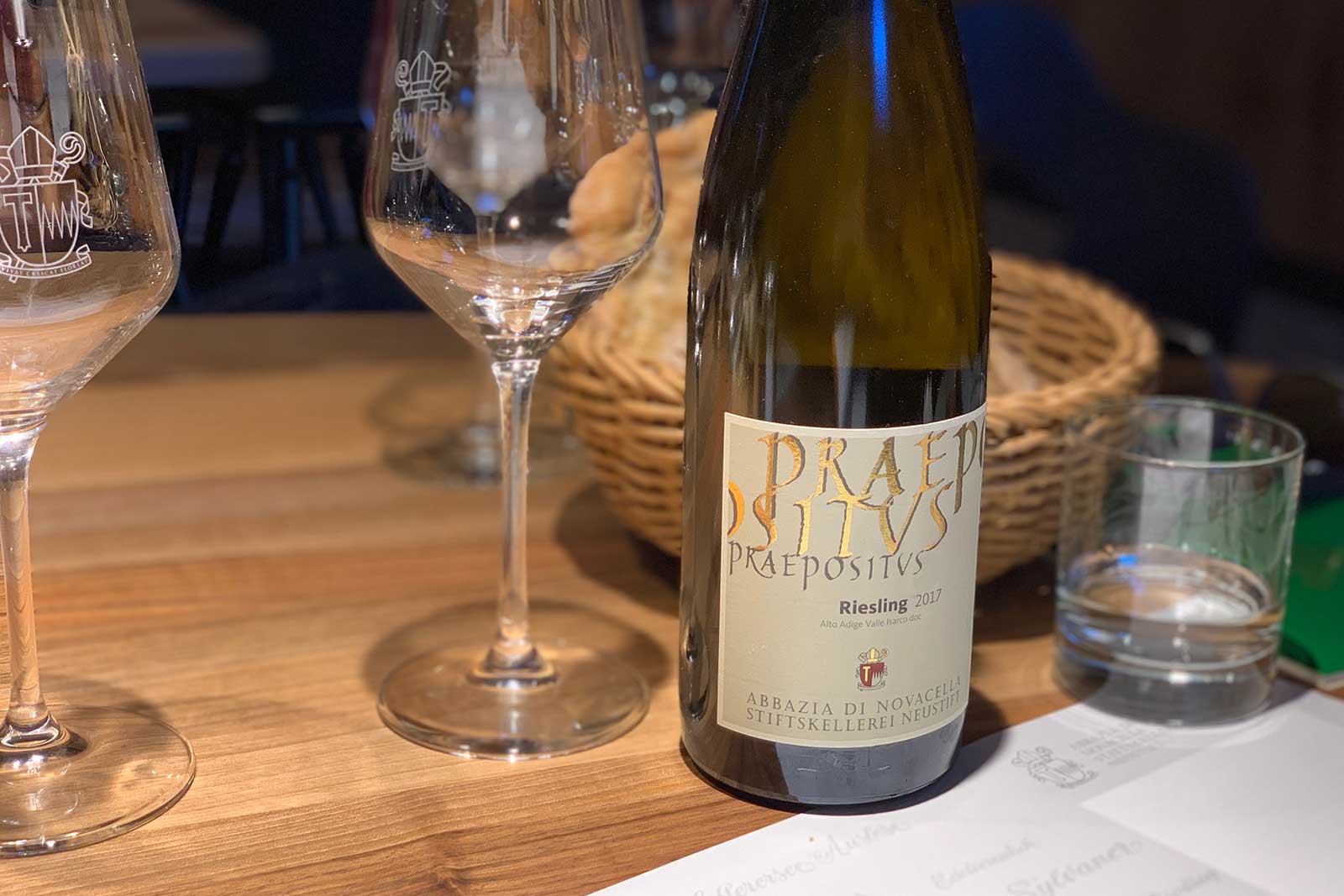
Abbazia di Novacella Riesling
The last of the white wines I sampled was the 2017 Praepositus Riesling (★★★★ 1/2). This is a very market-friendly, crowd-pleasing Riesling with none of the “petroleum” notes that, for some, mar their impression of this grape. It is also vinified dry even though 10% of the grapes were harvested late. This fact seems to express itself in the bouquet, which is decidedly sweet and invigorating (i.e. rather than apples, it conjured notes of apple sauce). A dash of lemon, a pinch of honeycomb and a swath of brittle hay added some subtle intrigue to the wine’s tones.
Abbazia di Novacella St. Magdelener
On to the reds. While Alto Adige’s whites are increasingly international in style and substance, the reds share tones from other alpine wines, particularly Switzerland and Valle d’Aosta. St. Magdelener (aka Santa Maddalena) refers to the light but structured wines hailing from the spectacular hill above Bolzano. Comprised mostly of Schiava (90%) with a dash of Lagrein (10%), Abbazia di Novacella’s 2017 St. Magdelener (★★★★ 1/2) is a classic chill-in-summer red wine that pairs beautifully with aged cheeses. Tart cherries and bitter blackberries define its profile on the nose, while the miniscule amounts of tannin on the palate allow the acidity to cut and rinse any food you might be noshing on. I prefer St. Magdelener to straight Schiava, and the abbey’s is a shining example.
Abbazia di Novacella Pinot Nero
Pinot Nero (yep, the same thing as Pinot Noir) has had a presence in Alto Adige since the mid-1800s. It thrives lower in the valley in an area called Bassa Atesina where the vines stay in the shade for much of the morning due to the imposing cliffs that line the valley. Abbazia di Novacella has had a stake in the Pinot Nero game for a while, and the 2018 Pinot Nero (★★★★ 1/4) is fresh, fruity and simple; another summer sipper. If you are more accustom to American-style Pinot Noir, you’re more likely to enjoy the rich and spicy 2015 Praepositus Pinot Nero (★★★★ 3/4). Defined by aromas of black raspberries, cherries, cinnamon stick and peppercorn, the Praepositus picks up its spicy character from a small inclusion of stems in the pressing of the juice. It is aged 18 months in a mixture of tonneaux and barrique, with 10 months in bottle.
Abbazia di Novacella Lagrein
Lastly, I sampled Abbazia di Novacella’s Lagrein. This ancient grape is the offspring of Trentino’s Teroldego, and it registers some of the highest counts of anthocyanin of all Italian red grapes. It’s dark color makes it a brooding wine, and the 2018 Lagrein (★★★★ 1/2) from Abbazia di Novacella is a great introduction. It’s kirsch-like fruit tones are cut by an edge of slate. Even more precise and balanced is the 2015 Praepositus Lagrein (★★★★ 3/4) which is simultaneously delicious and fresh, yet ready to be unpacked if you are on a quest for tasting notes. Recollections of black raspberries, black cherries, plums, rose and licorice all came to the fore on the nose. A superb ending to a comprehensive and intriguing tasting.
